Tranzeo Wireless Technologies 49PSS-CM9 Wireless Networking Device User Manual TR 49 rev 2 0 pub
Tranzeo Wireless Technologies, Inc Wireless Networking Device TR 49 rev 2 0 pub
users manual
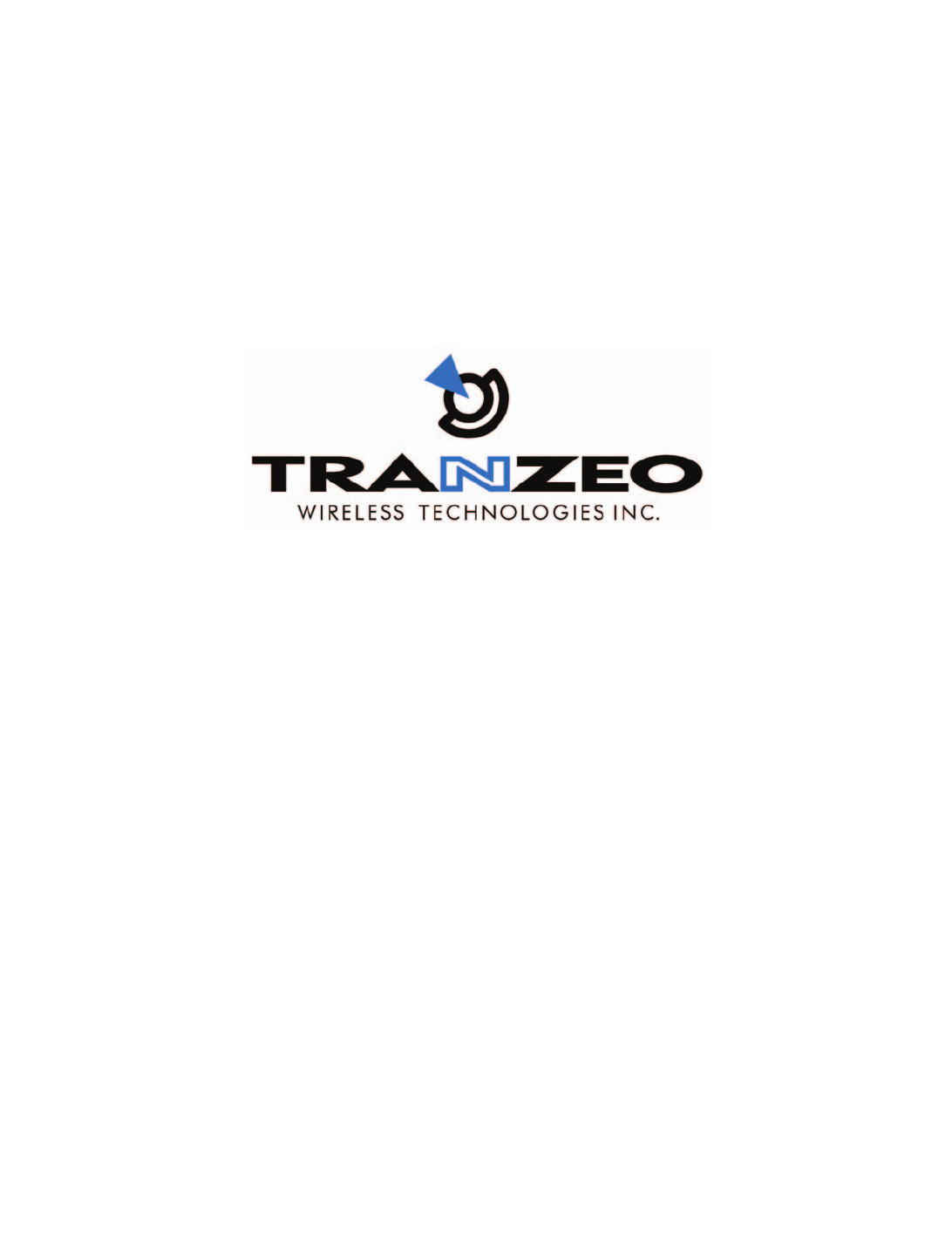
QUICK START GUIDE FOR THE
TRANZEO WIRELESS TR-49
REVISION 2.0a
JANUARY 2ND, 2006

FCC Information
This equipment has been tested and found to comply with the limits for a Class B digital device pursuant to
part 15 of the FCC Rules. These limits are designed to provide reasonable protection against harmful
interference when the equipment is operated in a Residential environment. This equipment generates, uses,
and can radiate radio frequency energy and, if not installed and used in accordance with the instruction
manual, may cause harmful interference to radio communication.
Operation in the 4940-4990 MHz band is restricted to the U.S. Operation in this range is restricted to the Public
safety bands. Use of these bands is restricted to entities that meet the requirements listed the FCC Part 90.20
Public Safety Pool and are properly licensed to operate a transmitter in the Public Safety band in accordance
with Part 90Y of the technical rules can operate in the 4940-4990 MHz band. FCC regulations state in Part 90,
operation in the 4.9-GHz band requires frequency coordination before the system can be operated.
Operation of this equipment in residential area is likely to cause harmful interference in which case the user will
be required to correct the interference at his or her own expense.
The user should not modify or change this equipment without written approval from Tranzeo Wireless.
Modification could void authority to use this equipment.
For the safety reasons, people should not work in a situation which RF Exposure limits be exceeded. To
prevent the situation happening, people who work with the antenna should be aware of the following rules
1. Install the antenna in a location where a distance of 65 cm from the antenna may be maintained.
2. While installing the antenna, do not turn on power to the unit.
3. Do not connect the antenna while the device is in operation.
4. The antenna used for this transmitter must not be co-located or operating in conjunction with any other
antenna or transmitter.
Safety Notices
Safety Precautions:
YOU MUST READ AND UNDERSTAND THE FOLLOWING SAFETY INSTRUCTIONS BEFORE
INSTALLING THE DEVICE:
• This antenna’s grounding system must be installed according to Article 810-15, 810-20, 810-21 of the
National Electric Code, ANSI/NFPA No. 70-1993. If you have any questions or doubts about your
antenna grounding system, contact a local licensed electrician.
• Never attach the Grounding Wire while the device is powered.
• If the ground is to be attached to an existing electrical circuit, turn off the circuit before attaching the
wire.
• Use the Tranzeo POE only with approved Tranzeo models.
• Never install Radio Equipment, surge suppressors, or lightning protection during a storm.
A BRIEF WORD ON LIGHTNING PROTECTION
The key to a Lightning Protection is providing a harmless route for lightning to reach ground. The system
should not be designed to attract lightning, nor can it repel lightning. National, State and local codes are
designed to protect life, limb and property, and must always be obeyed.
When in doubt, consult contact an electrician or professional trained in the design of
grounding systems.

Introduction
This next-generation wireless LAN device – the TRANZEO TR-49, brings Ethernet-like performance
to the wireless realm. The TRANZEO TR-49 also provides powerful features such as the Internet-
based configuration utility as well as WEP and WPA security. Maximize network efficiency while
minimizing your network investment and maintenance costs.
TR-AP Quick Start Guide Hardware Installation
Product Kit
Before installation, make sure that you have the following items:
• The TR-49 x 1
• DC Power Adapter x 1
• Power over Ethernet Adapter x 1
• Ethernet Boot x 1
• Mounting Bracket x 1
• Kept Nuts (With Washer Attached) x 8
• U-Bolt w/ 2 Nuts x 1
• RJ-45 Patch Cable x 1
• Ethernet Boot Gasket x 1
• Ethernet Cable Lock x 1
If any of the above items is not included or damaged, please contact your local dealer for support.
In this Manual, the symbol will be used to indicate changes that were introduced in
Version 2.0.

Mechanical Description
LED panel of the Wireless LAN Smart Access Point
The following table provides an overview of each LED activity:
LED Definition Activity Description
In AP mode the signal lights indicate the following:
Power Supply
ONLY use the power adapter supplied with the TR-49. Otherwise, the product may be damaged.
Label Color Indicators
POWER Red On: Powered On
Off: No Power
LAN Green On: Ethernet Link
Flashing : Ethernet Traffic
Off: No Ethernet Link
Radio Amber On: Radio Link
Flashing Radio Activity
Off: No Radio Link
Signal Red/Amber/Green In CPE mode, light up in sequence to indicate signal strength
Color Indicators
Red On: WEP/128 Enabled
Flashing: WEP/64 Enabled
Off: WEP Off
Amber On: WPA/AES Enabled
Flashing : WPA/TKIP Enabled
Off: WPA Off
Amber No Function in 4.9
Green On: ACL Enabled
Off: ACL Off
Green On: WDS Enabled
Off: WDS Off

Hardware Installation
Take the following steps to set up your TR-49.
Site Selection: Before installation, determine the TR-49 unit’s location. Proper placement of the unit
is critical to ensure optimum radio range and performance. You should perform a Site Survey to
determine the optimal location. Ensure the CPE is within line-of-sight of the Access Point.
Obstructions may impede performance of the unit.
Tools Required to Install
• One 3/8 wrench
• One 3/4 wrench
• One RJ-45 crimper
• A suitable length of Cat 5 cable to bring the signal from the unit to the Power over Ethernet
Adaptor
• 2 RJ-45 Jacks
Before installing, you must determine if the unit will be in the horizontal or vertical orientation. The
TR-49 model can be mounted in either orientation. The Ethernet boot should always be placed so
that the cable runs toward the ground for maximum environmental protection.
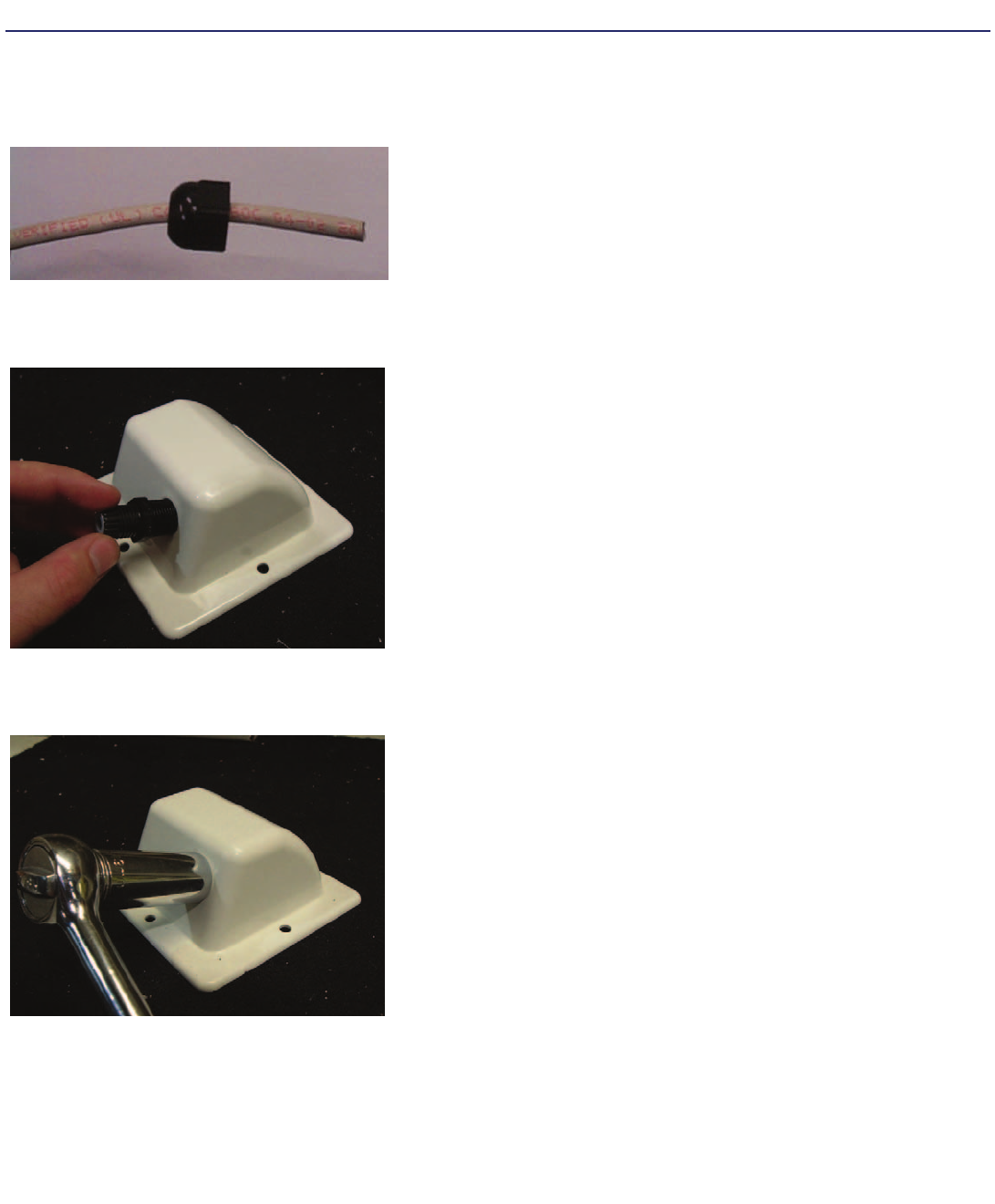
Connecting the Ethernet Cable
Step 1
Step 2
Step 3
Place the Ethernet Boot Cover over the end of
your Cat 5 cable.
Attach Ethernet Cable Lock on side of the
Ethernet Boot. This is easiest to do before you
attach the RJ-45 Jack.
Tighten using a ¾” wrench or socket. Tighten
until the Cable Lock touches the Boot as shown
in Step 3.

Step 4
Step 5
Step 7
Repeat steps 2 & 3 to attach the second Ethernet
Cable Lock if you purchased the optional dual
port boot.
Place Sealing Gasket over screws.
Insert the Cat 5 Cable and tighten the Boot
Cover. Be sure to pull enough cable through to
reach the RJ-45 connector with an RJ-45 jack at-
tached. The Gasket must be attached to the
Boot so that it sits between the radio and the
boot.
Hand tighten only. DO NOT OVERTIGHTEN as
you may damage the environment seal.
Remove gasket backing and place boot cover on
radio. This will ensure that you attach the sticky
side of the gasket to the underside of the
Ethernet Boot. Make sure the Gasket is free of
gaps.
Step 6
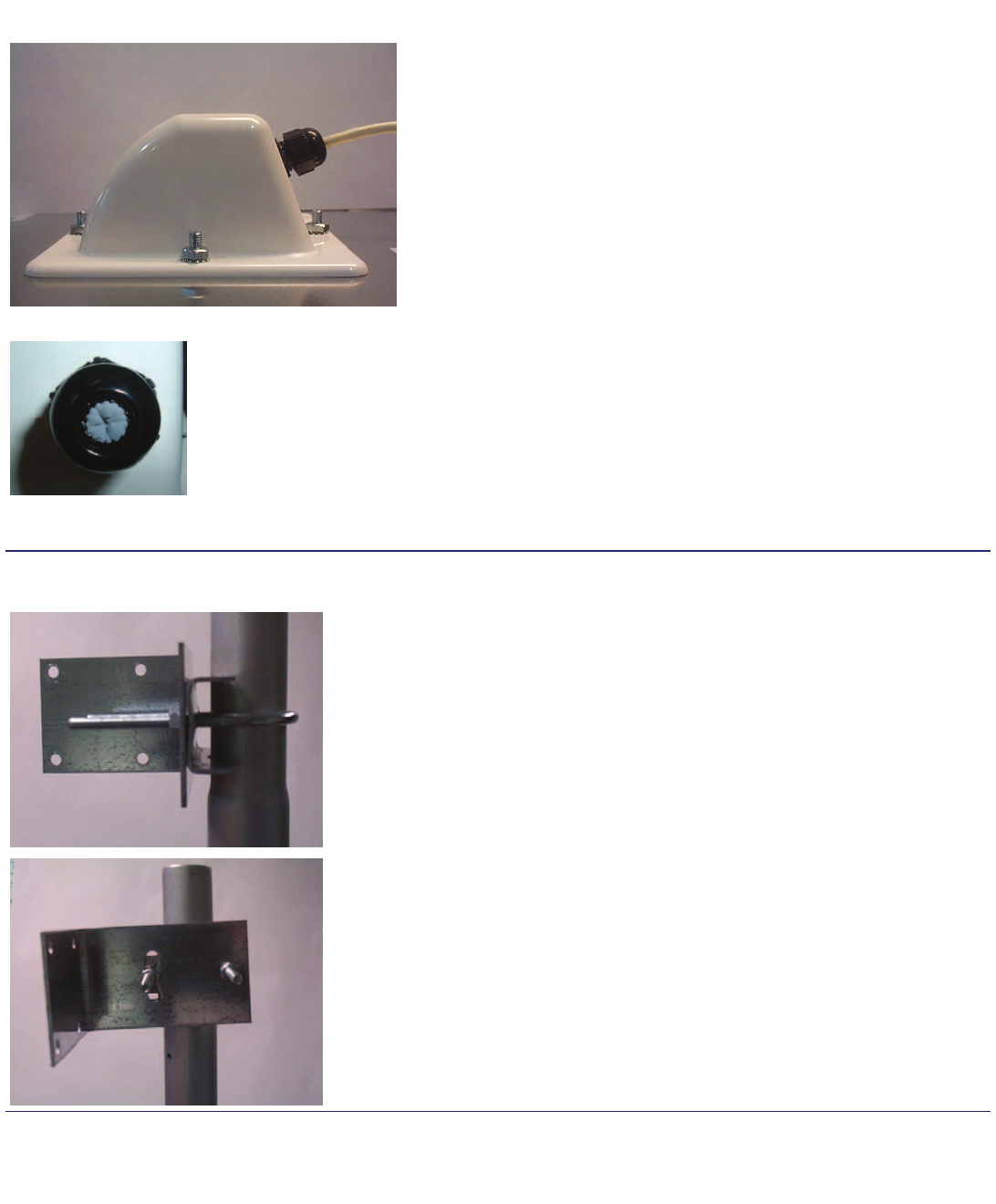
Step 8
Attaching the Mounting Bracket
Grounding the Antenna
Using a #6 Green grounding wire, connect the Grounding Lug on the radio to a proper ground. See
APPENDIX A Lighting Information for more information.
Place the Ethernet boot over the 4 Screw Posts.
Apply 4 Kept nuts to the screw posts and tighten
until the gasket makes full contact with the
Ethernet boot. The gasket should be at least
50% compressed.
As shown below, the U-Bolt is designed to mount
around a pole. Tighten bolts sufficiently to
prevent any movement.
Down or up tilt can be adjusted by swinging the
unit before tightening the U-Bolt.
Optional dual port boot specific note.
If you are not going to be using the second port
make sure that it is tightened down to ensure a
weather-tight seal.

Connect the Power Cable
Dual Ethernet Ports
The TR-49 has two Ethernet port available. Port A is used to connect to the radio in the radio in the
case. Port B is used to power and provide Ethernet connectivity to additional devices. This allows
for the daisy chaining of multiple devices together.
Connect the power adapter to the power
socket on the Power over Ethernet Adaptor
(POE), and plug the other end of the power
into an electrical outlet. Plug the RJ-45 Ca-
ble from the unit into the POE. The Station
Adaptor will be powered on and the power
indicator on the top panel will turn on.
NOTE: ONLY use the power adapter sup-
plied with the Access Point. Otherwise, the
product may be damaged.
This unit must be grounded. Connect the
Green Grounding Cable to a known good
earth ground, as outlined in the National
Electrical Code.
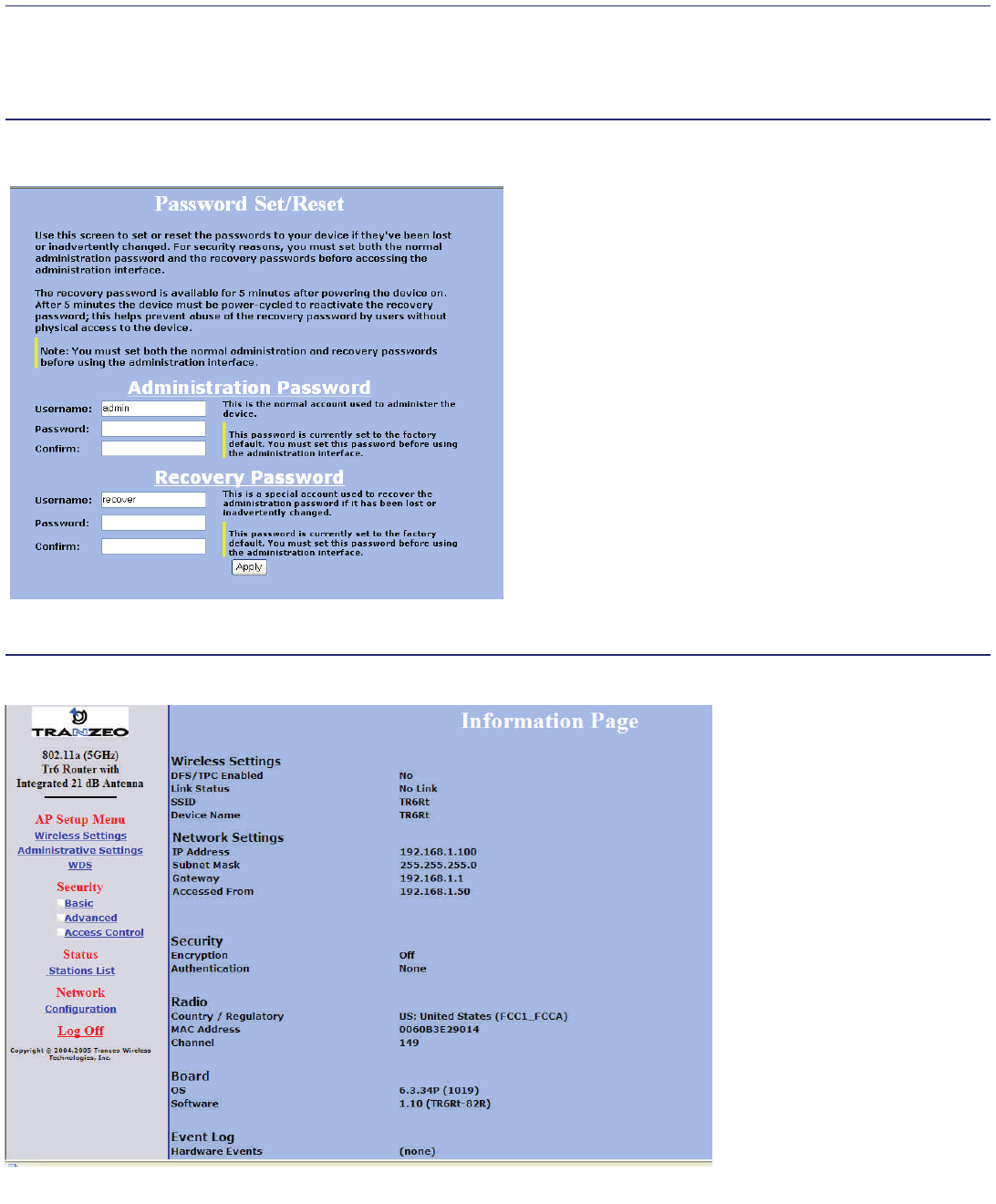
HTML Interface
NOTE: The default IP address is 192.168.1.100
The default User Name is admin
The default Password is default
Passwords
Information
When you first enter the Web Interface, you will
be required to enter a new recovery password.
This password is intended to allow the ISP to
change the password of the device if they forget
it. This password must be different than the
operator password. Neither password can be
left at default. These passwords must be
changed to access the device. If you do not
enter new passwords, you will return to this
webpage.
In the frame on the
left, select the option
you wish to configure.
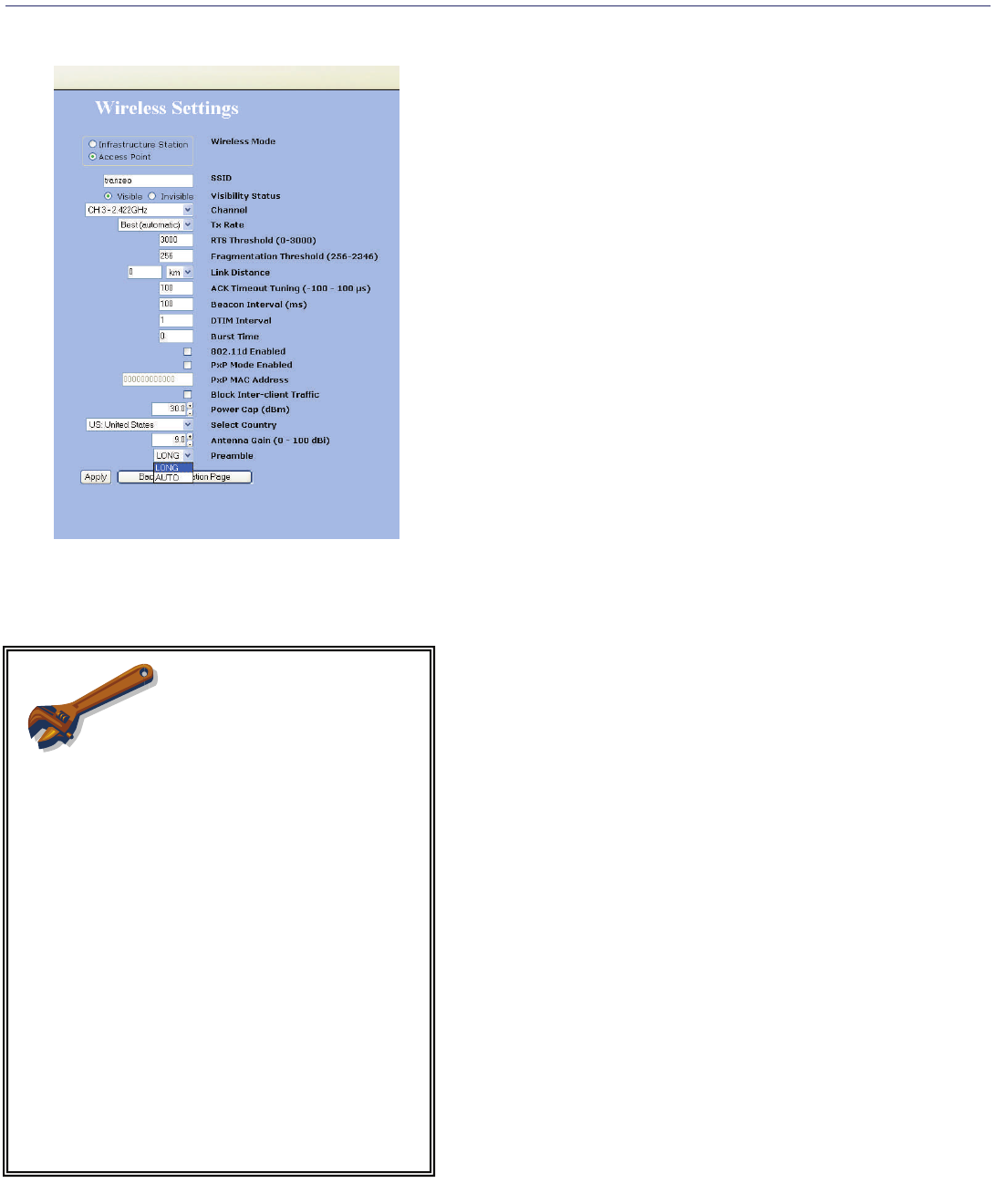
Wireless Settings
SSID
The SSID is a unique ID given to an Access Point.
Wireless clients associating to the Access Point must have the
same SSID. The SSID can have up to 32 characters.
Visibility Status
Makes the AP visible or invisible to clients.
Channel
Sets the channel that the AP and clients will use
TX Rate
The rate at which the radio will communicate with the clients.
NOTE: Setting this rate below the maximum possible does not
limit bandwidth, and often has a negative impact on the
operation of your network.
RTS Threshold (0-3000)
Select RTS that works best in your location. A general rule of
thumb is the more clients you have, the lower the value should
be set.
Fragmentation Threshold
Select Fragmentation that works best in your location. The
lower the Fragmentation, the smaller the packets.
Link Distance
Sets the distance of the link for correct ACK timing.
ACK Timeout Tuning (µs)
For fine tuning the ACK timing if required.
Beacon Interval
Sets the rate at which the AP will broadcast its beacons.
DTIM Interval
Sets the DTIM (Delivery Traffic Indication Message) Interval.
Helps to keep marginal clients connected by sending wake up
frames.
Burst Time
Sets the Burst Time in ms. which will be used to send data without
stopping. Note that other wireless devices in that network will not
be able to transmit data for this number of microseconds.
802.11d Enabled
Enable 802.11d mode. Not used in operation in the United
States or Canada.
Block Inter-Client Traffic
Select to block wireless communications between clients on the
AP.
Power Cap (dBm)
Sets the output power of the radio.
Preamble
You can now set the preamble type: Long or Auto. Auto tries Short
first, then Long. Long uses Long only. This feature was added to
workaround some competitive AP’s that did not support Auto
Preamble.
PXP How to:
To operate the radio in PXP mode, one radio
needs to be set to Access Point and the other
set to Infrastructure.
♦ Set the SSID to be the same on both
radios
♦ Channel is set by the AP
♦ Enter in the opposite radios’ MAC ad-
dress into the PxP Mac address field on
both radios (no colons)
♦ Check off “PxP Mode Enabled”
Note: The LEDS on the radios will operate the
same as in Infrastructure mode, with LEDS pro-
portional to signal strength.
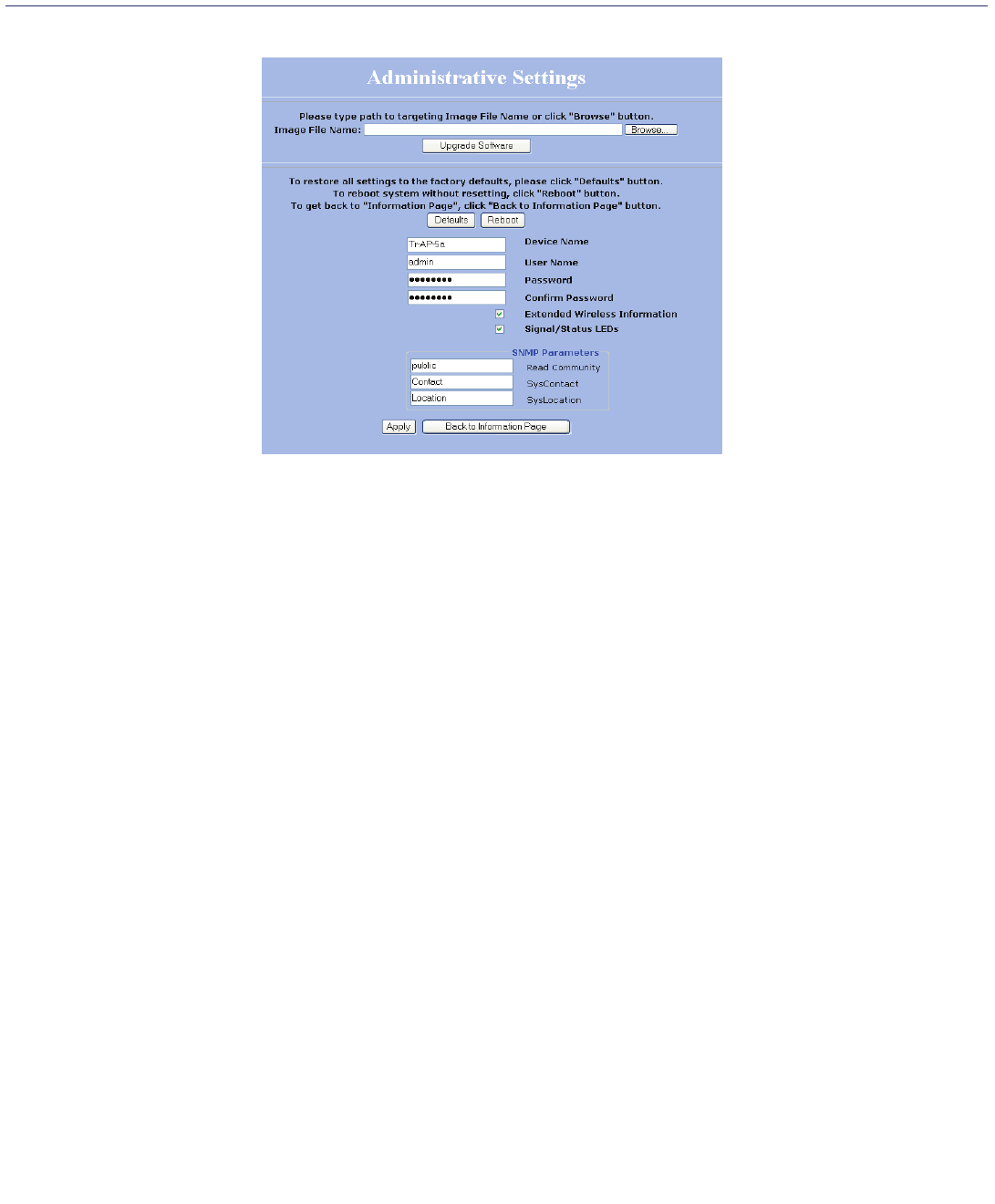
Image File Name
Enter the location of the Firmware update file, or use Browse to locate the file in your PC, and then press “Upgrade Soft-
ware”
Defaults
Returns all settings to factory defaults.
Device Name
The network name of the device.
User Name
The access user name.
Password/Confirm Password
Enter the password for accessing the device
Ext. Info Enabled
Enable extended information. Extended information is only displayed with Tranzeo Wireless Technologies Access
Points.
Signal / Status LEDs
Un-select to turn off the LEDs on the unit.
SMNP Parameters
Here you set the Read Community string and Contact / Location data. It is highly recommended that you change the
SNMP Read Community string immediately to prevent unauthorized scanning of your network.
Version 2.0 supports MIB-II and the 80211 mib.
Note: The in and out values are in 64 bit values to accommodate the high amount of traffic that could pass through a
backhaul link. This should not impact any monitoring program.
Administrative Settings
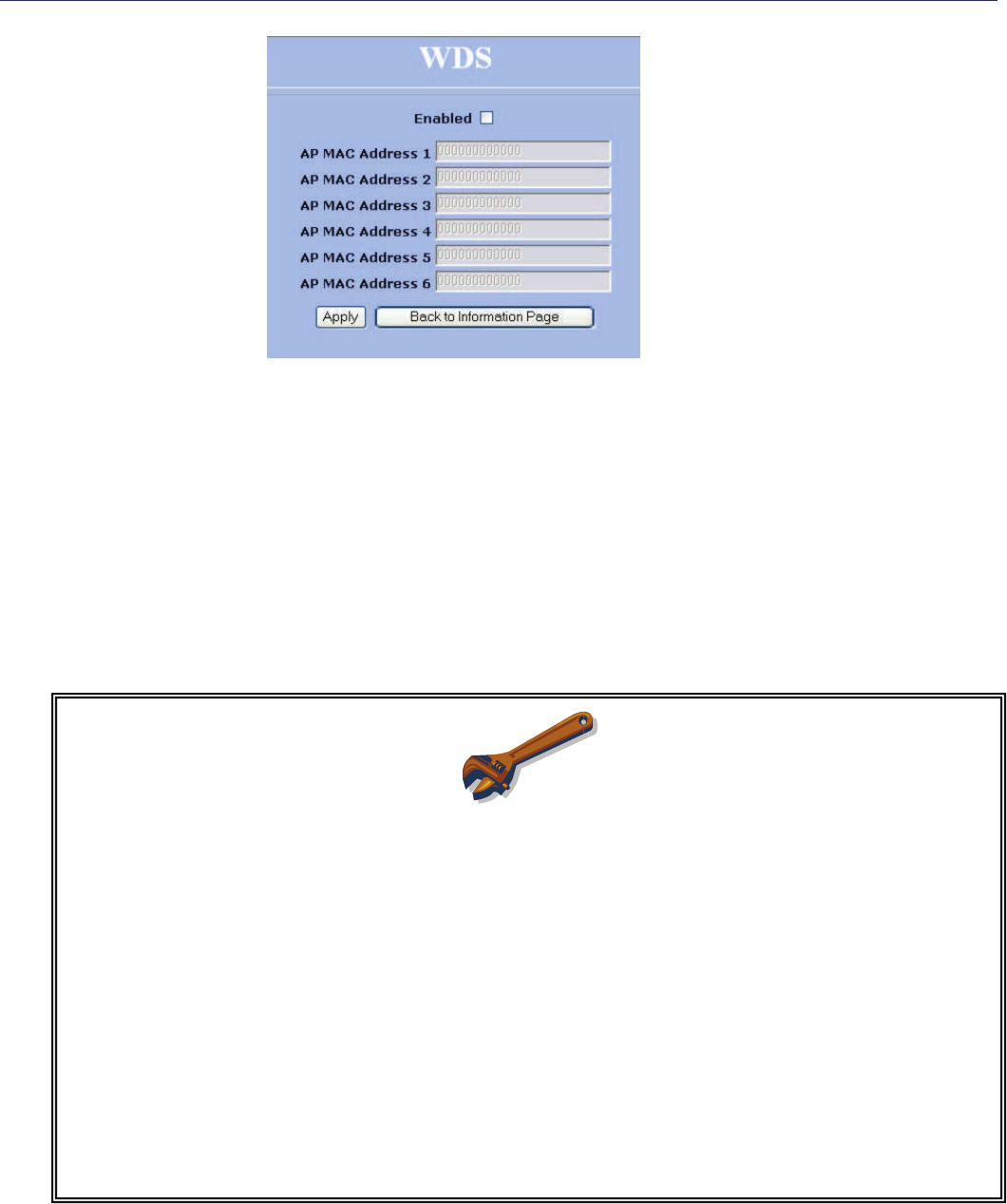
WDS (Wireless Distribution System) is a modification to the 802.11 spec that allows AP to communicate
directly with each other. WDS allows users to spread out coverage to a larger area without the need for a
backhaul link. The tradeoff is that overall throughput is greatly affected for all users of the AP’s linked. WDS is
not recommended for use with large numbers of clients, or in cases where throughput needs to be maximized.
In cases were large numbers of users are involved, or maximum throughput is need a dedicated PxP link
should be used. However, in areas of low density WDS can allow an ISP to extend coverage into an area at
very low cost.
Enabled
Select this box to enable WDS
HOW TO SET UP WDS
♦ Default the Unit to factory settings.
♦ Check the Wireless Settings of the APs.
♦ SSIDs can be different but the Channels MUST be the same
♦ Under the WDS settings add in the MAC address of the PEER. Unit A gets Unit B's ad-
dress, Unit B gets Unit A's address. Do not insert colons or commas.
♦ Click 'Apply'
♦ Ping a station connected to the opposite end. It should reply.
Considerations for the Use of WDS
1) WDS Links do not appear in the station list or the performance tab. If you need to be able to
monitor the link’s strength and performance you should use PxP mode.
2) Throughput is cut by 50% per link.
3) WDS does not support WPA encryption.
4) All links need to be on the same channel.
WDS
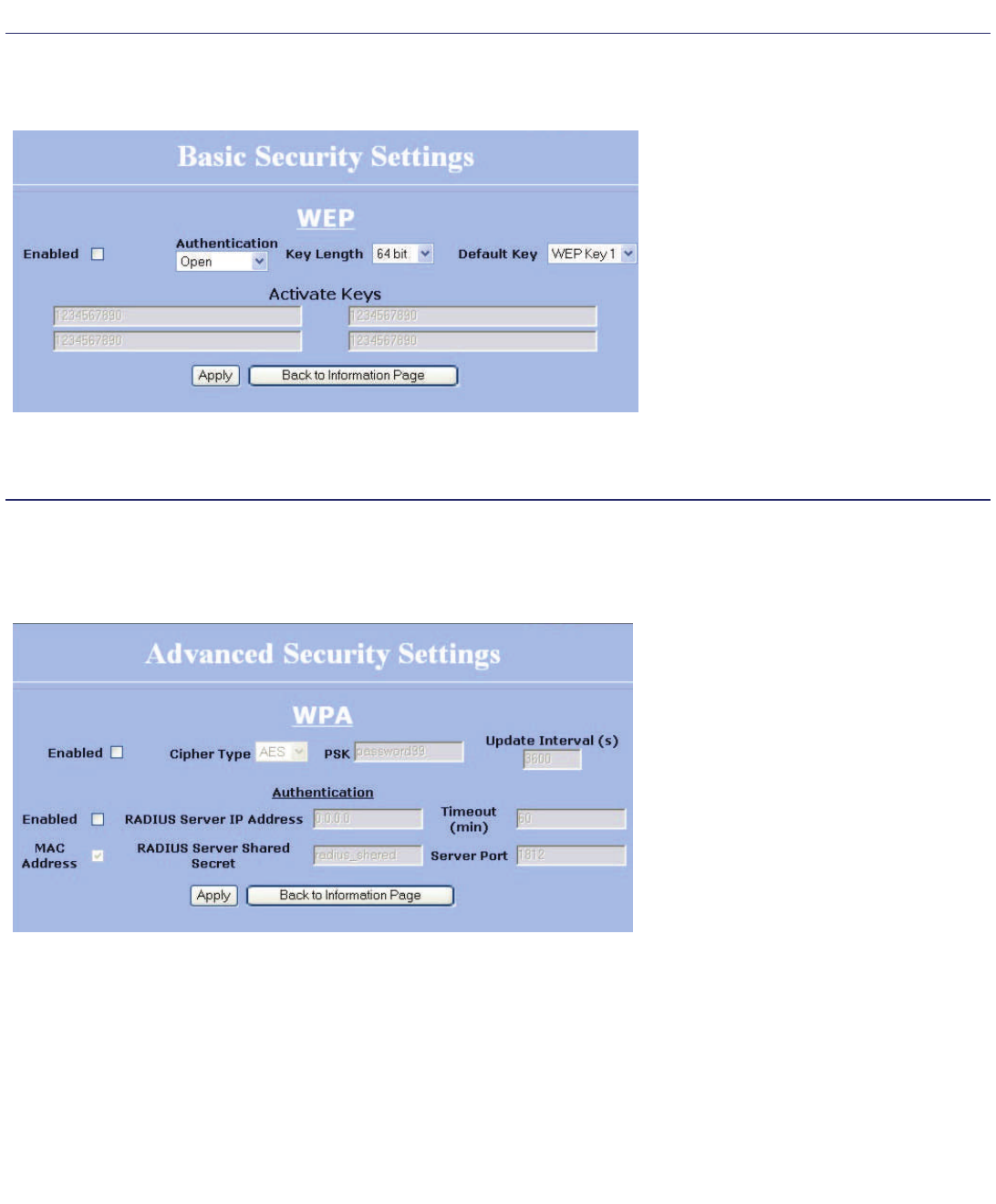
Security Settings—Basic
Security Settings—Advanced
Enabled
Turn On WEP
Authentication
Select Open or Shared Key
Authentication
Key Length
Level of Encryption. NOTE: 64 bit is
referred to as 40 bit on some systems
Default Key
Choose the default WEP key
Activate Keys
Enter your WEP keys. NOTE: Keys must
be entered in HEX only.
Enabled
Turn On WPA
Cipher Type
Select the Level of Encryption.
TKIP or AES
PSK
Enter your password
Update Interval
Enter the update interval
Enabled
Turn on 802.1x RADIUS Server Au-
thentication
RADIUS Server IP Address
Enter the server IP
Timeout (min)
Enter the timeout period
RADIUS Server Shared Secret
Enter the name of the server
Server Port
Enter the port of the server

This document is intended for Public Distribution 19473 Fraser Way
Access Control
Enable Access Control
Select this box to enable access control.
Associated Wireless Devices
Click any devices to disassociate them
Wireless Devices Available
Click any wireless device that should be associated with the AP
Associate With This Station Manually
Enter the MAC address of a client and then click “add” to associate with it.
Changes to Access Control
NOTE: If you are working via a radio link, the first MAC you should add is the address of the station you are
connecting from. Otherwise, you will lock yourself out of the radio.
1. The Manually Authorize Stations section allows you to enter a long list of MAC address.
2. You can also select specific station that are already authorized and copy them to the Manually Authorize
Stations box.
3. Data in the Manually Authorize Stations box can be copied to the clipboard to be pasted into another unit or a
text file.
4. The Move button moves the MAC Address from Manually Authorize Stations to the Unauthorized list and vice
versa.
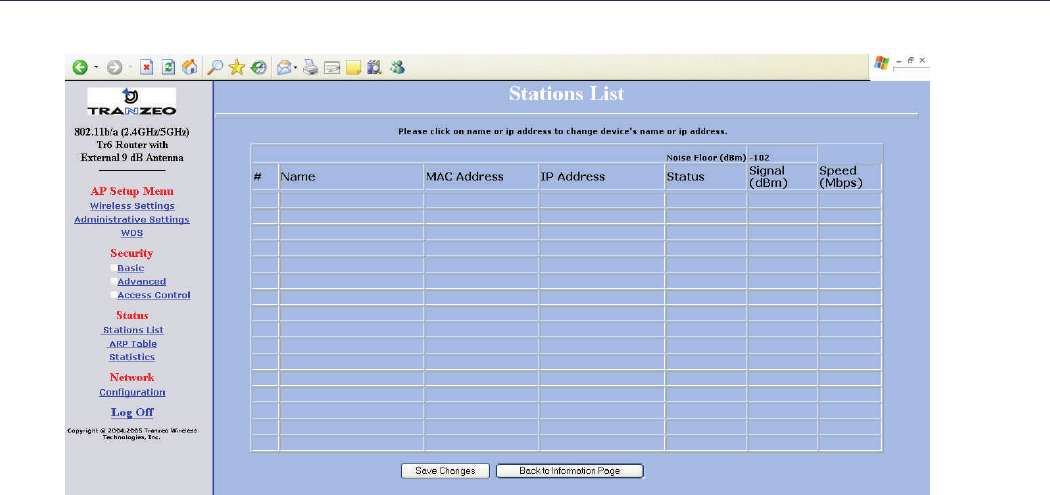
This page displays a list of the stations associated with the AP and their connection statistics.
The first column is simply the order in which the stations are stored in the Station Table.
The second column is the name field. If the device is a Tranzeo 49, and it has the Extended Info option turned on in the
Administrative Settings Window, then the device name will appear here. Otherwise, the field will be blank.
You can enter a name into the field by left clicking onto the field and typing the name in. This name will be retained.
However, if the Extended Info is turned on at the client, the name will be overwritten with the name on the client.
The third column is the IP address. As with the name, if the client supplies it via the Extended Info option, it will appear.
Otherwise you can manually enter it.
The fourth column in is the Status field.
The fifth column is the RF power in dBm as detected at the AP. This is one element of a strong link, the signal of the
client end being another. Links should also be at least 10 dB higher than the receive sensitivity of the weakest element
or the noise floor, whichever is higher, on both sides.
The sixth columns shows the radio speed of the link. Speed is based on both signal strength and the quality of the link.
If the link is losing a lot of packets due to poor Fresnel zones or interference, the speed will be lower than the strength
can support.
Stations List (AP Mode Only)
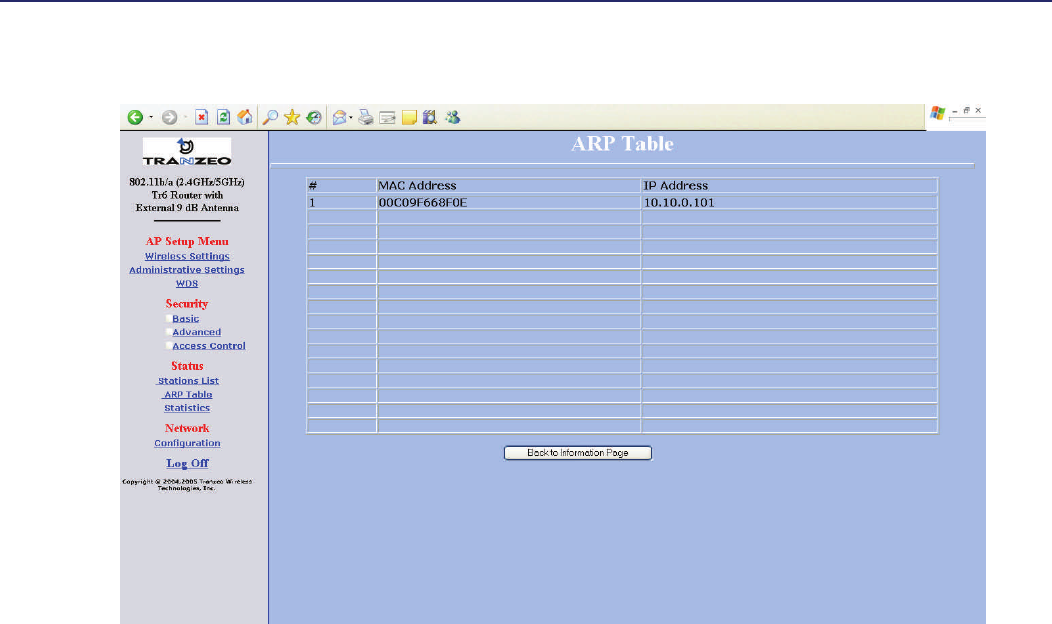
ARP Table
This feature was added as a troubleshooting screen. It shows the devices which have sent either a broadcast or
directly tried to communicate with the device. Under normal circumstances, there should be a limited number of
entries in this table, especially if you have interstation blocking turned on at the AP.

Network Configuration – Bridge Mode
This page allows you to control the network configuration
of the device.
You can choose Static or DHCP Client IP configuration
for the device.
Note: If you select DHCP, and a DHCP server is not pre-
sent, the device will try to get an IP for up to 5 minutes.
At the end on 5 minutes, it will fall back to a static IP.
You can then locate it using the Locator Program and
change it back to static.
You can also set the Ethernet Speed on this page.
Note: Many Ethernet devices do not auto-negotiate prop-
erly. If you see large numbers of dropped pings, you may
be have collisions. Try locking the device at 10 / Half as
a troubleshooting step. If the packet losses stop, step up
to 100 / Half. If the device the radio is connecting can
not support 100 / Half, you should replace the device or
place a switch in line.
Network Configuration – Router Mode
You can choose Static, DHCP or PPPoE Client IP
configuration for the device. Each of these options are
explained on the following pages.
Note: If you select DHCP, and a DHCP server is not
present, the device will try to get an IP for up to 5
minutes. At the end on 5 minutes, it will fall back to a
static IP. You can then locate it using the Locator
Program and change it back to static.
If you select a PPPoE client, and no PPPoE server can
be found, you may be not be able to access the device
from the WAN side. You will still be able to access it from
the non-PPPoE interface.
You can also set the Ethernet Speed on this page.
Note: Many Ethernet devices do not auto-negotiate
properly. If you see large numbers of dropped pings, you
may be have collisions. Try locking the device at 10 /
Half as a troubleshooting step. If the packet losses stop,
step up to 100 / Half. If the device the radio is
connecting can not support 100 / Half, you should replace
the device or place a switch in line.

This document is intended for Public Distribution 19473 Fraser Way
DHCP Server Configuration
Subnet Mask Subnet mask for the DHCP pool.
Address Range
Starting Address The starting address of the DHCP
pool.
The addresses are sequential starting with the
Starting Address.
Number of Addresses
The number of addresses you
want to have in the DHCP pool
Gateway Select This Unit to use the gate-
way set on the WAN interface of
the radio or select Other to set a
different gateway address.
DNS
WAN-Assigned Select to use the DNS server
addresses as assigned on the
WAN side.
Static Select to set DNS servers if
different than those on the
WAN side.
Note: If you select this option but leave the field
blank or set to 0.0.0.0 the client will not get a
DNS server value of 0.0.0.0. You must enter a
value into this field to use a static DNS.
Domain Name and WINS operate the same as DNS.
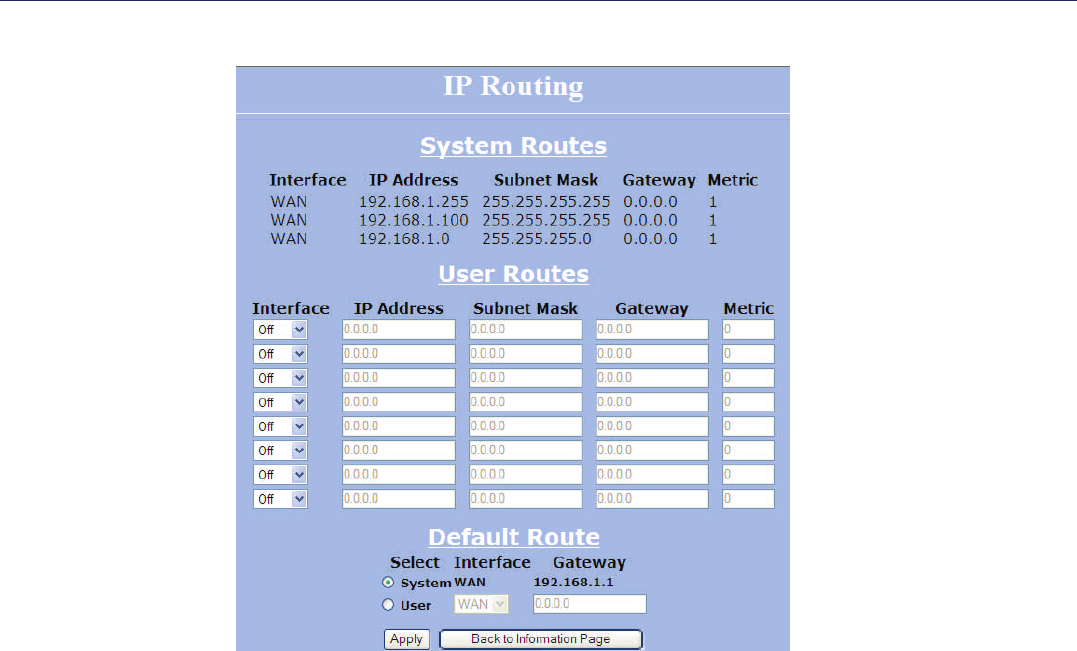
Routing is an incredibility complex topic that is way beyond the scope of a QuickStart or Manual. This screen is
intended for those users who have a strong understanding of IP Routing. Misconfiguration on this screen could
result in serious network problems or even the loss of functionality.
Menu Options
Static Routes—Adds a new route to the IP routing table.
System Routes—This section shows the current routing table entries.
Interface—Specifies whether the entry will be enabled or disabled, and what interface it should use transmit the packet.
IP Address—The IP address or network that the packets will be attempting to access
Subnet Mask—Used to specify which portion of the Destination IP signifies the network trying to be accessed and which
part signifies the host that the packets will be routed to.
Note: 255.255.255.255 is used to signify only the host that was entered in the Destination IP field.
Gateway—Specifies the next hop to be taken if this route is used. A gateway of 0.0.0.0 implies there is no next hop, and
the IP address matched is directly connected to the router on the interface specified:
Metric—The number of hops it will take to reach the Destination IP or network. A hop is considered to be traffic passing
through a router from one network to another. If there is only one router between your network and the Destination
network, then the Metric value would be 1.
Default Route—Allows the user to change the default route of the radio. This option should be used with extreme
caution.
Static Routing Setup Screen
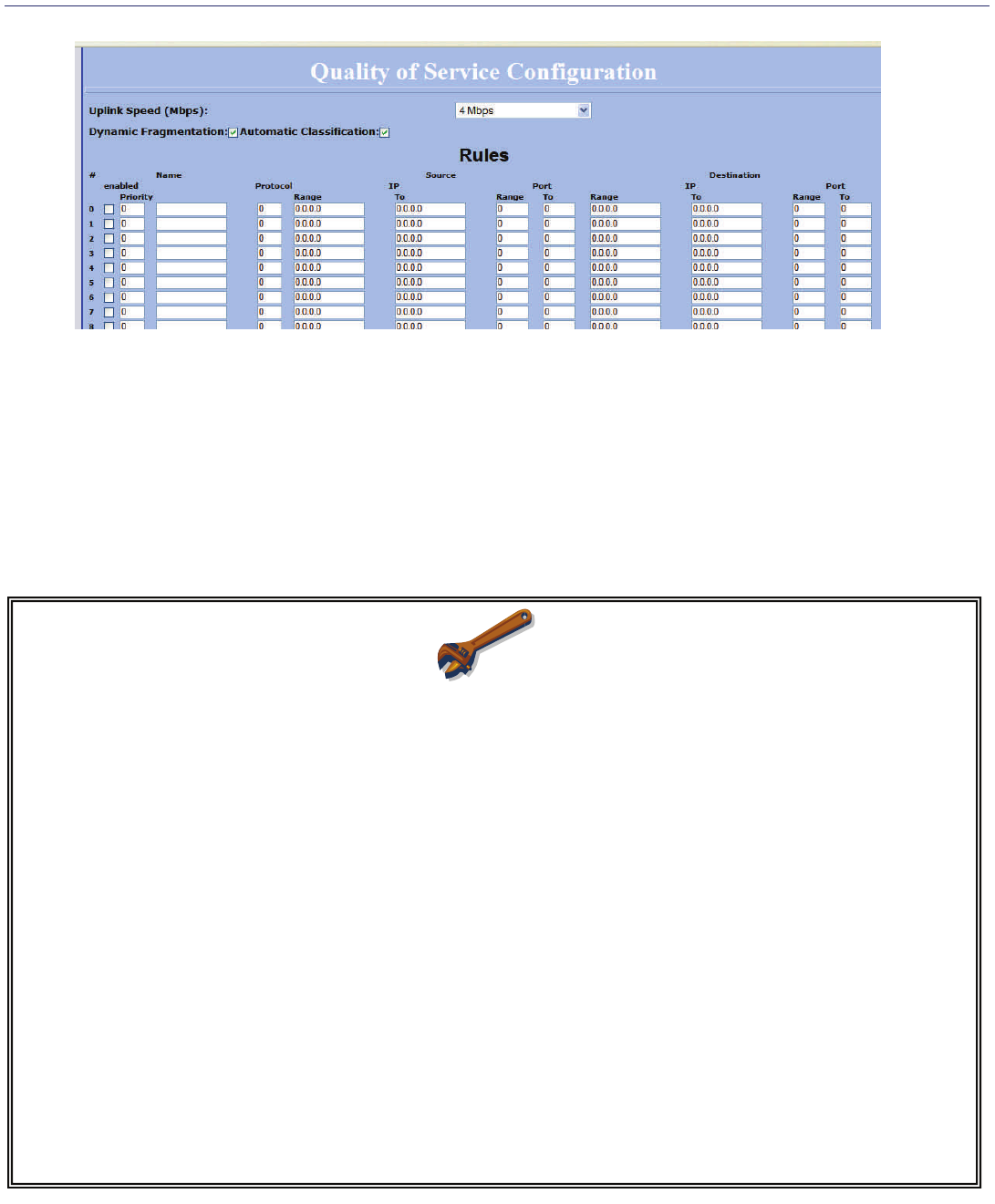
QOS
Menu Options
Uplink Speed ( Mbps)
Sets the maximum total pipe size for this client. The order and traffic size is determined based on this value.
Dynamic Fragmentation Reduce delay for high-priority traffic and adaptive fragmentation where the fragmentation is
determined by the uplink speed. This feature greatly
improves the gaming and VOIP experience.
Automatic Classification
In vast majority of cases, this is all you need to select for best results. Applications such as VOIP, Gaming, etc are
automatically given priority.
QOS RULES
If you chose to add you own rules, here are the various options:
Enabled You must select enabled to turn the rule on
Priority The lower the number, the higher it priority. 0 is the highest priority and 255 in lowest.
Name The name here is for your reference only.
Protocol Enter the IP Protocol Number Common options are: 0 for ANY, 1 for
ICMP, 6 for TCP, and 17 for UDP. See Appendix A – IP Protocol numbers.
Source IP Range Enter the range of the IP Addresses on the LAN side that the rule should apply to Enter
0.0.0.0 to apply the rule to all LAN IPs, otherwise enter the highest and lowest IP. For
a single IP enter the same IP in both boxes
Source Port Range Enter the range of the Ports on the LAN side that the rule should apply to. Enter 0 to
apply the rule to all Ports. For a single port enter the same port in both boxes
Destination IP Range Enter the range of the IP Addresses on the WAN side that the rule should apply to.
Destination Port Range Enter the range of the Ports that on the WAN side the rule should apply To.
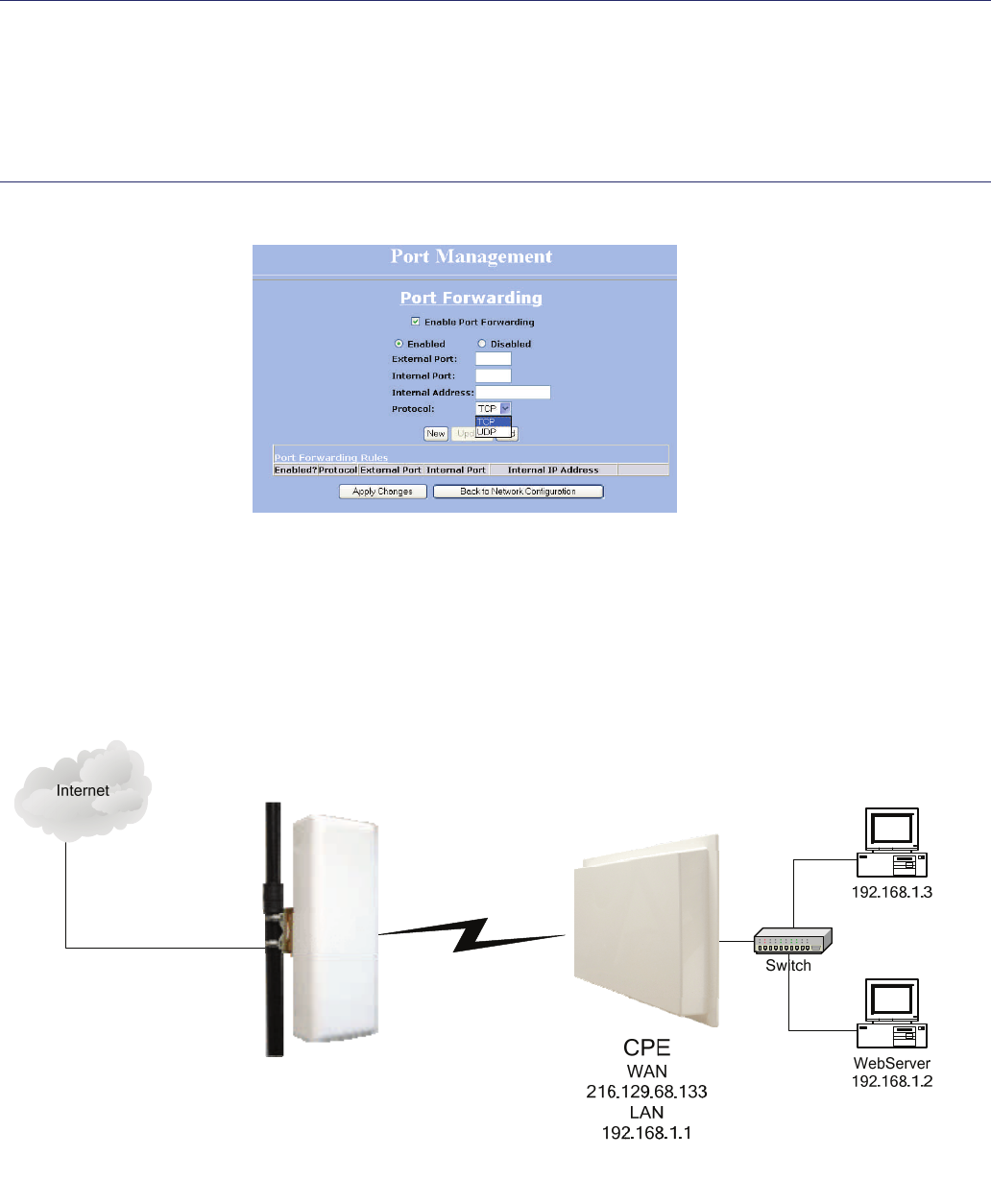
Cloning MAC
This is a new feature. It allows the CPE the clone the MAC of the device behind it. This feature can be useful
when dealing wth some PPPoE and Radius Implimentations. When the device is in Cloning MAC mode, it can
only be managed from the LAN side of the device.
Port Management
Port Forwarding
This is a new feature. It allows the radio to forward requests for certain ports to devices behind the router. For
example, the customer has a webserver behind the Radio on a Private Ip that they want to have accessable to the
world, then you can port forward all requests on Port 80 to 192.168.1.2.
Note: In order for this example to work, the management port of the radio would have to changed from port 80 on
the Network Configuration screen.
80
80
192.168.1.2

Port Filtering
This is a new feature. It allows the radio to block requests for certain IP’s or ports to and from devices behind
the router. For example, if a customer wishes to block access to FTP from this network to the outside world, you
would
1. Click Add
2. Select Deny
3. Select Source IP Range. Assuming that the clients are on 192.168.1.0/24, then the source IP would be
192.168.1.1 to 192.168.1.254
4. Select Desintination IP Range. Assuming that the entire outside world was to be blocked, then 0.0.0.0
should entered. 0.0.0.0 indictes all IP’s
5. Select Source Port Range. In this case, enter 0 for all Ports
6. Ignore ICMP type. This field allows you to block certain types of ICMP as a prevention against port scanning
and some viruses
7. Select the Protocol. In this case it would be TCP
8. You must click Apply Changes to save the rule
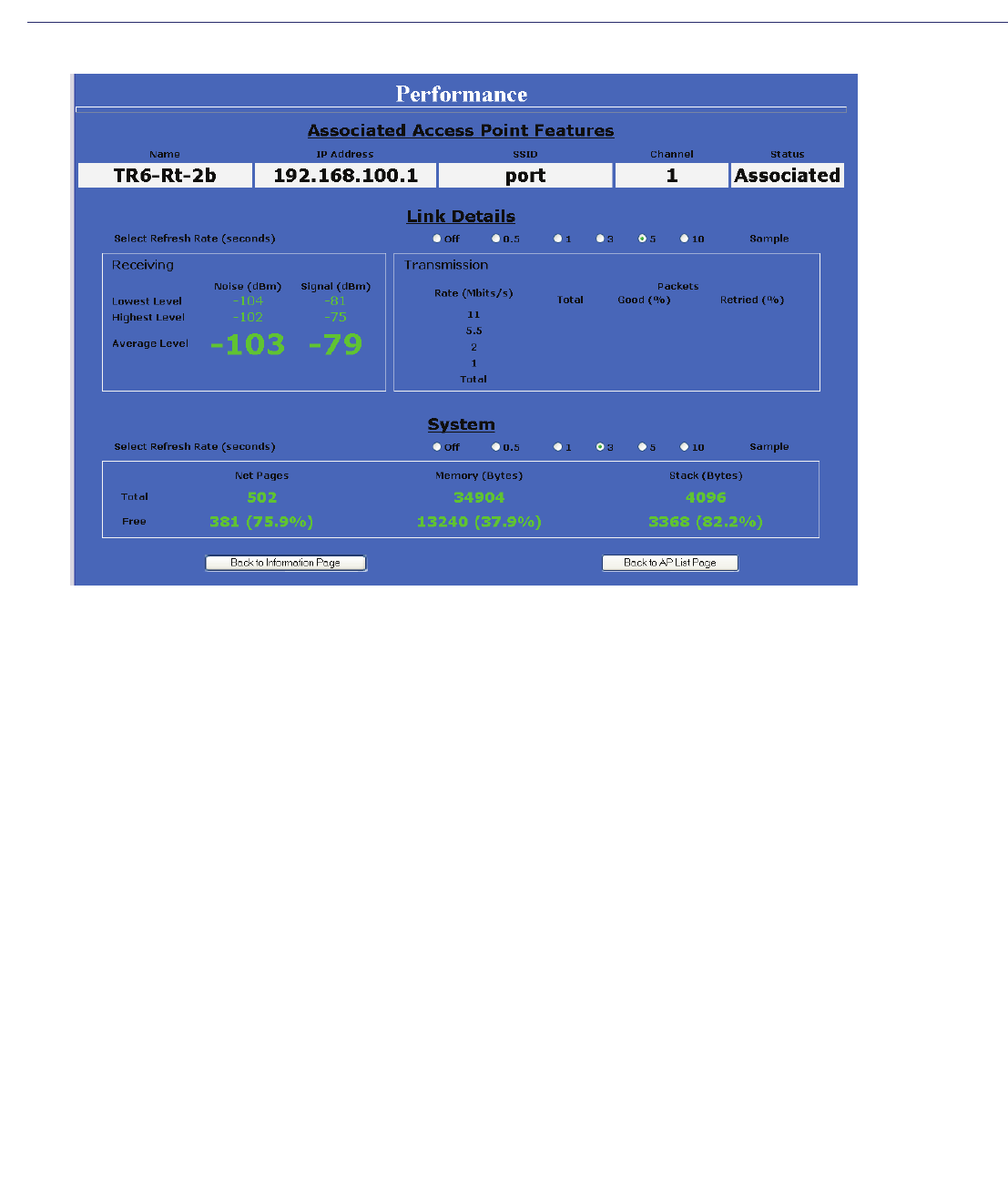
This document is intended for Public Distribution 19473 Fraser Way
Select Refresh Rate
Each radio button represents a Refresh Rate. Many browsers do not allow infinite refreshes of a page through scripts,
so this page may stop updating. If it does, simply change the Refresh rate to another value to restart the process.
Associated Access Point
Information about the access point is displayed here. Some items will only be displayed if the Access Point is a
Tranzeo TR-49 series AP with the Extended Info turned on in the Administrative Settings Window.
Receiving
This box displays the current signal and the Lowest and Highest values. For the most accurate readings, data must be
transmitted through the unit.
Transmission
This box displays the current signal traffic breakdown. For the most accurate readings, data must be transmitted
through the unit. Beacons are always transmitted at the lowest possible rate. This screen only shows the values dur-
ing the refresh rate. For more detailed statistics so the Statistics screen
System
This box displays the current Memory usage. It will fluctuate during normal usage. This data is mainly for the use of
Tranzeo Wireless Technical Support.
System Performance (CPE and PxP Modes only)
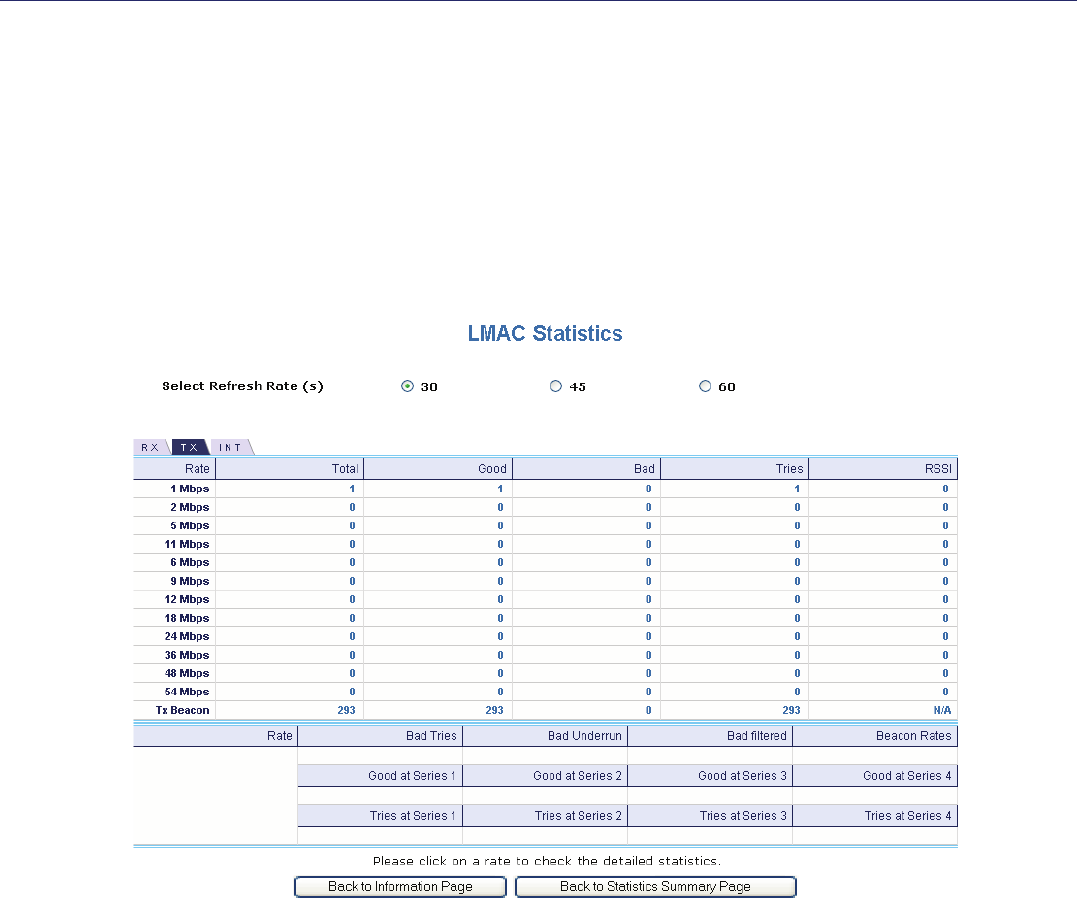
Statistics
The Statistics Screen is divided into 3 main areas, UMAC*, LMAC* and Ethernet. For Radio Troubleshooting, the UMAC
statistics are likely the most useful. The UMAC breaks down the statistics into Good and Bad Packets, whereas LMAC defines
why the packets are bad.
The statistics are further divided into TX, RX and INT. TX and RX values are useful to ISPs and other users. The INT (Internal)
stats are intended for use by Tranzeo Wireless Technical Support.
* Technical Info:
UMAC or Upper MAC functions occur in the Unit’s Processor.
LMAC or Lower MAC functions occur in the Radio Chipset.
You can click onto each speed level and see how the traffic breaks down. In the TX statistics, there should little to no Tries at
Series 2, 3 or 4. The radio will try to send a packet 4 times at Series 1, and then tries the next series 4 times. In the RX stats, you
should look for Bad CRC’s and Bad Decrypts for signs of RF interference or Fresnel interference links.
Bad PHY’s generally are caused when the radio is unable to decode the packets due to noise.
Note: Communication between APs and Stations always occurs at the lowest rate. In a normal link you should see a fair number
of transactions at the lowest rate.
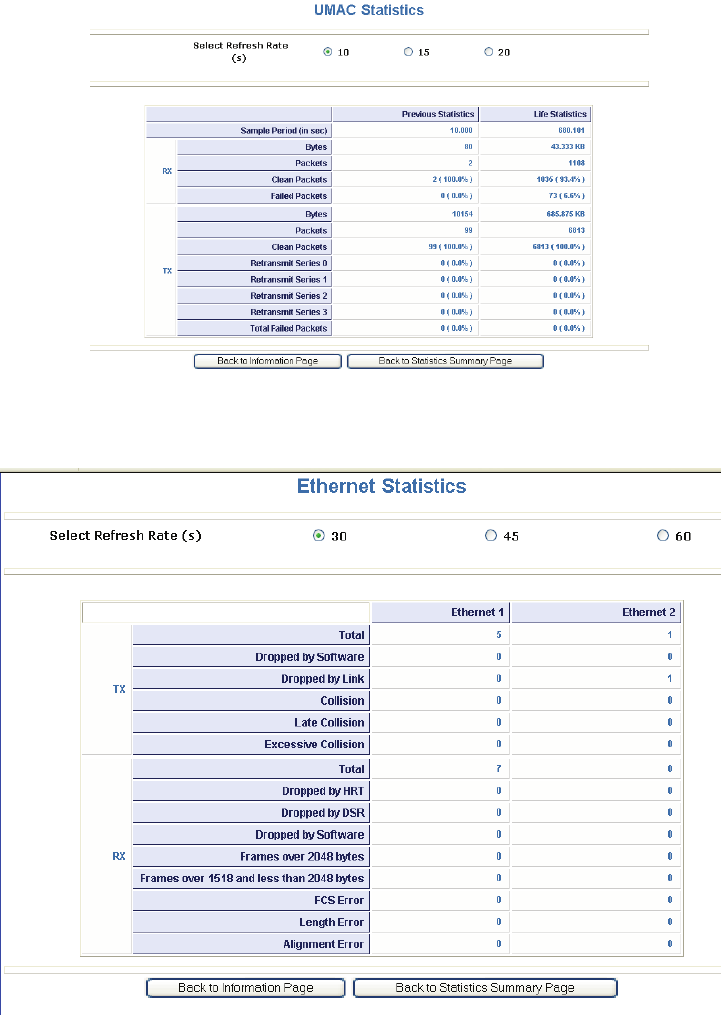
The failed packets should be 1% or less in a normal operating environment. In the TX statistics, there should little to no
Retransmits at Series 2, 3 or 4. Life Statistics are reset on each reboot.
In the Ethernet Statistics screen, excessive collisions are usually a sign that the radio and the device it is linked to
are not on the same Duplex options. One is at full while the other is at half. Try locking both to the same values.
Collisions do normally occur on an Ethernet network and are generally handled by the Carrier Sense Multiple Access
with Collision Detect (CSMA/CD) mechanism.
Alignment, Length and Excessive FCS errors could the result of a Bad Radio Link, or a bad Ethernet cable.

What is a proper Ground?
This antenna must be grounded to a proper Earth Ground.
According to the National Electrical Code Sections 810-15s and 810-21, the grounding
conductor shall be connected to the NEAREST accessible locations of the following:
a) The building / structure grounding electrode
b) The grounded interior metal water piping system
c) The power service accessible means external to enclosure
d) The metallic power service raceway
e) The service equipment enclosure
f) The grounding electrode conductor
The important thing is to connect to ground at the nearest point.
Why is coiling the LMR or CAT5 bad?
The myth is that lighting follows the path of least resistance. It actually follows the path of least
impedance. Coiling cables creates an air-wound transformer, which lowers the impedance. This
means you are in fact making your radios a more appealing target for surges.
What standard does Tranzeo Wireless equipment meet?
This radio exceeds International Standard IEC 61000-4-5 when properly grounded. For a copy of the
full testing report, see Report Number TRL090904 - Tranzeo Surge Protection board located on the
Tranzeo website.
Is lightning damaged covered by the Warranty?
No. Lightning is not covered by the warranty. If you follow the instructions, you chances of lightning
damage are greatly reduced, but nothing can protect a radio from a direct lightning strike.
Where to Ground the device
This radio must be grounded at the Pole AND at the POE. This is because the radio is between the
Exterior Antenna and the POE ground. See the examples below
APPENDIX A: Lightning Information
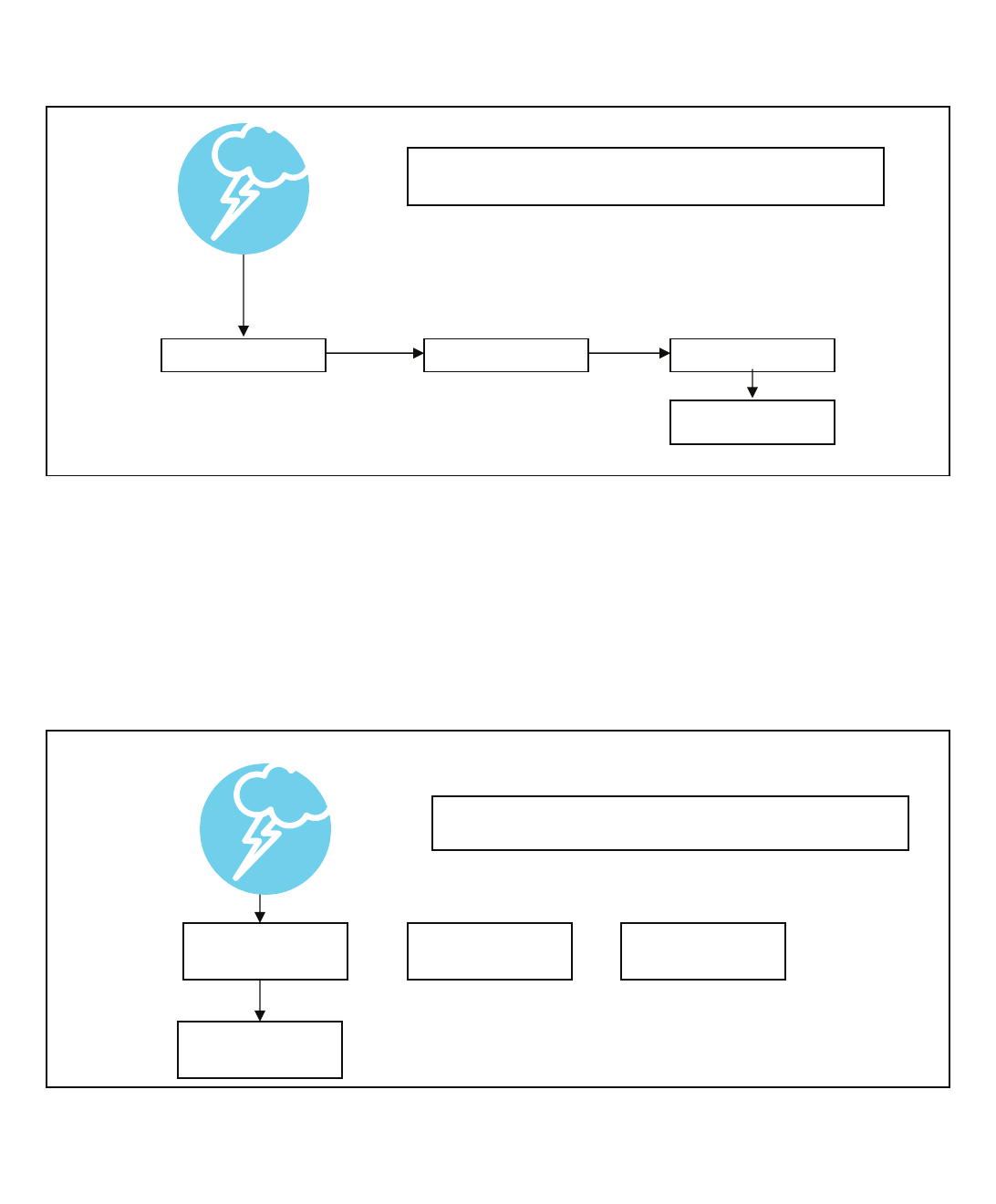
Ungrounded Radio
Grounded Radio
Antenna POE Radio
Ground
An ungrounded radio causes the surge to pass through the
radio. In this case the radio most likely will be damaged.
POE Antenna Radio
Ground
A grounded radio causes the surge to pass directly to ground,
bypassing the radio.
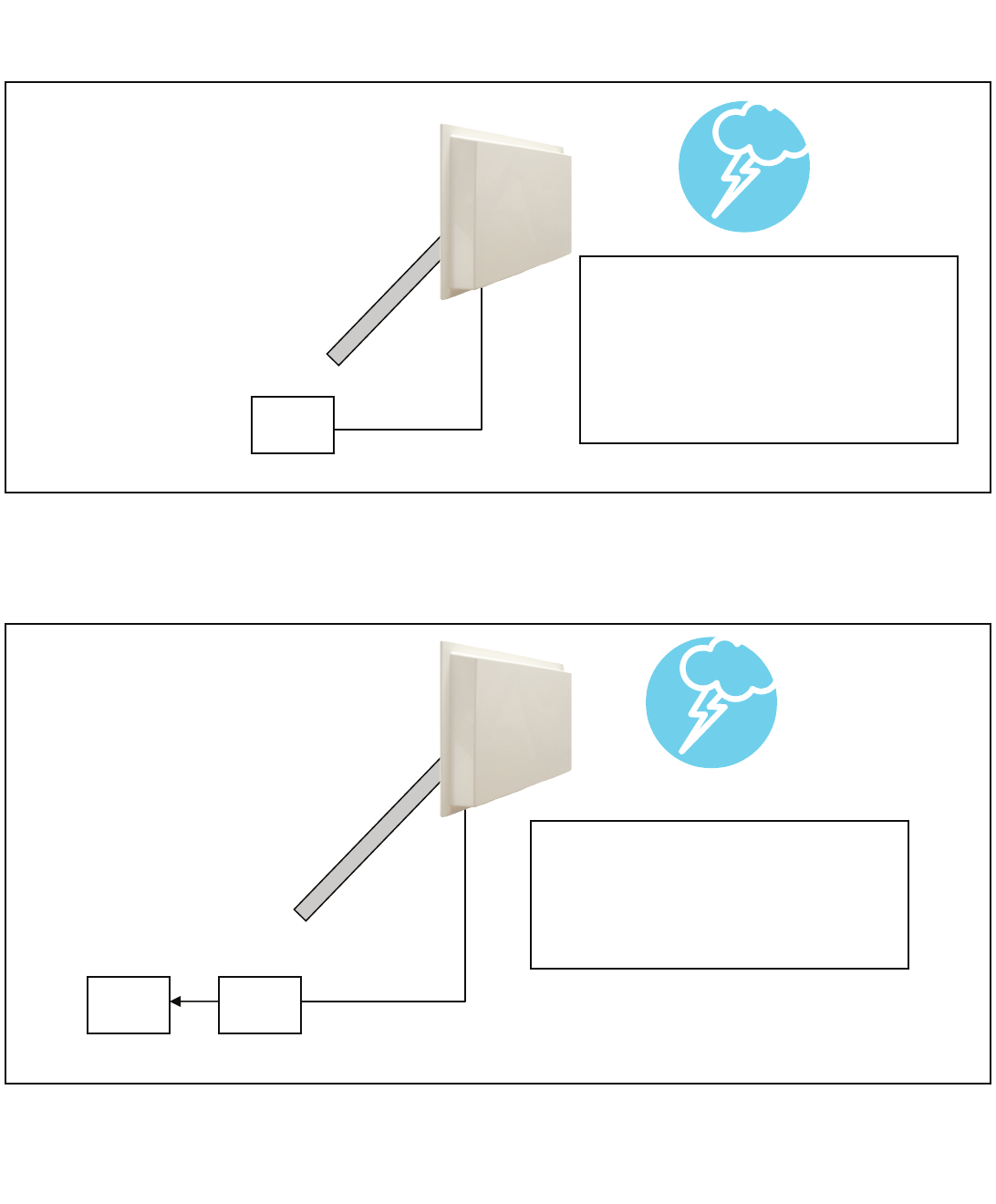
.
Cat 5 Cable
POE
In this case, the surge will be
picked up by the Cat 5 cable, and
since the POE is not grounded, the
route for the surge is through the
radio to the antenna, and out
through the building.
Mounting Pole
Mounting Pole
In this case, the surge will be
picked up by the Cat 5 cable, and
since the POE is grounded, the
route for the surge is through the
POE to ground.
Cat 5 Cable
POE
Ground

Best Practices
1) Always try to run the Cat5 and LMR inside of the mounting pole wherever possible. This helps
to insulate the cable from any air surges.
2) Keep all runs as straight as possible. Never put a loop into the cables.
3) Test all grounds to ensure that you are using a proper Ground. If using a electrical socket for
Ground, use a socket tester, such as Radio Shack 22-141
4) Buy a copy of the National Electrical Code Guide and follow it.
5) If you are in doubt about the grounding at the location, drive your own rod and bond it to the
house ground. At least you will know that one rod is correct in the system.
Cat 5 Cable
Building

APPENDIX B: QoS
QoS
Tranzeo Wireless Technologies’ software takes full advantage of technology to ensure a consistently high quality on-line
experience through the use of powerful Quality of Service (QoS) mechanisms. The key to making this applicable in a
WISP environment is the Intelligent Stream Handling, a patent-pending algorithm which autonomously manages the flow
of traffic going to the Internet, without the need for user configuration. As a result, real-time, interactive traffic, such as
gaming, VoIP and video teleconferencing, are automatically given the appropriate priority when other users and
applications use the connection. In addition, Intelligent Stream Handling minimizes the impact of large packet, lower
priority traffic on latency-sensitive traffic and eliminates delays. Tranzeo Wireless Technologies’ software effectively
eliminates the lag and breakup problem in online gaming and other voice/video applications.
In today's broadband environment the impact of just one data stream running in parallel with a real-time application can
be quite dramatic. Using NetIQ's Chariot VoIP test measurement over a connection, it can be demonstrated that
introducing a single FTP transfer in the upstream direction will reduce the Mean Opinion Score (MOS) for a G.729 VoIP
codec from a very good 4.4 to a completely unacceptable level of 1 immediately. Using the same scenario with Tranzeo
Wireless Technologies’ QOS enabled, the voice quality remains consistently high with an MOS of 4.4, and maintains that
level even with multiple FTP streams.
♦ Automatic Traffic Classification: Tranzeo Wireless Technologies’ software has the capability of continually
monitoring and classifying traffic on the Internet connection, and dynamically adjusting the way individual streams
are handled at any point in time. This enables latency-sensitive traffic, such as voice, games or even web page
requests, to be given a relatively high priority. As a result, these packets are sent to their destination first, reducing
delay and jitter. Less time-sensitive traffic such as email or file transfers are sent at lower priority. Since Intelligent
Stream Handling operates automatically without the need for user configuration, it is able to effectively make use of
255 priority levels for fine-grained control of the packet streams.
♦ Rate Matching: A process called "rate matching" determines the bandwidth of the broadband uplink automatically so
that it can shape the traffic to smooth the flow between the router and the Internet. This eliminates the potential
bottlenecks and delays that can be caused by "bursty" data traffic.
♦ Dynamic and Adaptive Link Fragmentation: Low priority traffic is also fragmented to reduce the latency and jitter
that can be introduced by long packets. Intelligent Stream Handling adjusts the fragment size based on the uplink
speed and also stops fragmenting long packets when no latency-sensitive traffic is waiting to be sent, to improve the
overall efficiency of the broadband link and ensure voice can sustain a high MOS rating.

Packet In Automatic
Classification
Non-latency-
sensitive traffic
Dynamic
Fragmentation
Queue
High Priority High Priority Rate Matching
Low – Priority or
excess Traffic
Queue
High Priority
Intelligent Stream Handling
adjusts the fragment size based on
the uplink speed and also stops
fragmenting long packets when
no latency-sensitive traffic is
waiting to be sent, to improve the
overall efficiency of the
broadband link and ensure voice
can sustain a high MOS*rating.
Tranzeo’s software has the capability of
continually monitoring and classifying traffic
on the Internet connection, and dynamically
adjusting the way individual streams are
handled at any point in time. This enables
latency-sensitive traffic, such as voice, games
or even web page requests, to be given a
relatively high priority. As a result, they are
sent to their destination first, reducing delay
and jitter. Less time-sensitive traffic such as
email or file transfers are de-prioritized.
A process called "rate matching"
determines the bandwidth of the
broadband uplink automatically
so that it can shape the traffic to
smooth the flow between the
router and the Internet. This
eliminates the potential
bottlenecks and delays that can be
caused by "bursty" data traffic.
Internet
QOS Block Diagram 1/13/2006
Tranzeo Wireless Technologies
*Mean Opinion Score (MOS)


Decimal Keyword Protocol
======= ======= ==============
0 HOPOPT IPv6 Hop-by-Hop Option
1 ICMP Internet Control Message
2 IGMP Internet Group Management
3 GGP Gateway-to-Gateway
4 IP IP in IP (encapsulation)
5 ST Stream
6 TCP Transmission Control
7 CBT CBT
8 EGP Exterior Gateway Protocol
9 IGP private interior gateway
10 BRM BBN RCC Monitoring
11 NVP-II Network Voice Protocol
12 PUP PUP
13 ARGUS ARGUS
14 EMCON EMCON
15 XNET Cross Net Debugger
16 CHAOS Chaos
17 UDP User Datagram
18 MUX Multiplexing
19 DCN-MEAS DCN Measurement
20 HMP Host Monitoring
21 PRM Packet Radio Measurement
22 XNS-IDP XEROX NS IDP
23 TRUNK-1 Trunk-1
24 TRUNK-2 Trunk-2
25 LEAF-1 Leaf-1
26 LEAF-2 Leaf-2
27 RDP Reliable Data Protocol
28 IRTP Internet Reliable Transaction
29 ISO-TP4 ISO Transport Class 4
30 NETBLT Bulk Data Transfer
31 MFE-NSP MFE Network Services
32 MERIT-INP MERIT Internodal Protocol
33 SEP Sequential Exchange
34 3PC Third Party Connect
35 IDPR Inter-Domain Policy Routing Protocol
36 XTP XTP
37 DDP Datagram Delivery
38 IDPR-CMTP IDPR Control Message Transport Proto
39 TP++ TP++ Transport Protocol
40 IL IL Transport Protocol
41 IPv6 Ipv6
42 SDRP Source Demand Routing
43 IPv6-Route Routing Header for IPv6
62 IPv6-Frag Fragment Header for IPv6
45 IDRP Inter-Domain Routing
46 RSVP Reservation Protocol
47 GRE General Routing Encapsulation
62 MHRP Mobile Host Routing Protocol
49 BNA BNA
50 ESP Encap Security Payload for IPv6
51 AH Authentication Header for IPv6
52 I-NLSP Integrated Net Layer Security
53 SWIPE IP with Encryption
54 NARP NBMA Address Resolution
55 MOBILE IP Mobility
Decimal Keyword Protocol
======= ======= ========
56 TLSP Transport Layer Security
using Kryptonet key
management
57 SKIP SKIP
58 IPv6-ICMP ICMP for IPv6
59 IPv6-NoNxt No Next Header for IPv6
60 IPv6-Opts Destination Options for IPv6
61 any host internal protocol
62 CFTP CFTP
63 any local network
64 SAT-EXPAK SATNET and Backroom EXPAK
65 KRYPTOLAN Kryptolan
66 RVD MIT Remote Virtual Disk
67 IPPC Internet Pluribus Packet Core
68 any distributed file system
69 SAT-MON SATNET Monitoring
70 VISA VISA Protocol
71 IPCV Internet Packet Core Utility
72 CPNX Computer Protocol Network
Executive
73 CPHB Computer Protocol Heart Beat
74 WSN Wang Span Network
75 PVP Packet Video Protocol
76 BR-SAT-MON Backroom SATNET Monitoring
77 SUN-ND SUN ND PROTOCOL-Temporary
78 WB-MON WIDEBAND Monitoring
79 WB-EXPAK WIDEBAND EXPAK
80 ISO-IP ISO Internet Protocol
81 VMTP VMTP
82 SECURE-VMTP SECURE-VMTP
83 VINES VINES
84 TTP TTPord Protocol
85 NSFNET-IGP NSFNET-IGP
86 DGP Dissimilar Gateway Protocol
87 TCF TCF
88 EIGRP EIGRP
89 OSPFIGP OSPFIGP
90 Sprite-RPC Sprite RPC Protocol
91 LARP Locus Address Resolution
92 MTP Multicast Transport Protocol
93 AX.25 AX.25 Frames
94 IPIP P-within-IP Encapsulation
95 MICP Mobile Internetworking Control
96 SCC-SP Semaphore Communications Sec.
97 ETHERIP Ethernet-within-IP Encapsulation
98 ENCAP Encapsulation Header
99 any private encryption scheme
100 GMTP GMTP
101 IFMP Ipsilon Flow Management
102 PNNI PNNI over IP
103 PIM Protocol Independent Multicast
104 ARIS ARIS
105 SCPS SCPS
106 QNX QNX
107 A/N Active Networks
108 IPComp IP Payload Compression
109 SNP Sitara Networks Protocol

APPENDIX D: Common TCP Ports
See http://www.iana.org/assignments/port-numbers for a full list of Well Known Port Numbers.
Keyword Port Description
======= ==== ===========
ECHO 7 Echo
SYSTAT 11 Active Users
QOTD 17 Quote of the day
MSP 18 Message Send Protocol
FTP-DATA 20 File Transfer (Data Channel)
FTP 21 File Transfer (Control)
TELNET 23 Telnet
SMTP 25 Simple Mail Transfer
NAME 42 TCP Nameserver
BOOTPS 67 Bootstrap Protocol Server
BOOTPC 68 Bootstrap Protocol Client
TFTP 69 Trivial File Transfer
WWW 80 World Wide Web
KERBEROS 88 Kerberos
POP3 110 TCP post office
NNTP 119 USENET
NFS 2049 Network File System
SIP 5060, 5061 SIP
108 IPComp IP Payload Compression
109 SNP Sitara Networks Protocol
110 Compaq-Peer Compaq Peer Protocol
112 VRRP Virtual Router Redundancy
113 PGM PGM Reliable Transport
114 any 0-hop protocol
115 L2TP Layer Two Tunneling Protocol
116 DDX D-II Data Exchange (DDX)
117 IATP Interactive Agent Transfer
118 STP Schedule Transfer Protocol
119 SRP SpectraLink Radio Protocol
120 UTI UTI
121 SMP Simple Message Protocol
122 SM SM
123 PTP Performance Transparency
124 ISSIS ISIS over IPv4
125 FIRE
126 CRTP Combat Radio Transport
127 CRUDP Combat Radio User Datagram
128 SSCOPMCE
129 IPLT
130 SPS Secure Packet Shield
131 PIPE Private IP Encapsulation within IP
132 SCTP Stream Control Transmission
133 FC Fibre Channel
134-254 Unassigned
255 Reserved